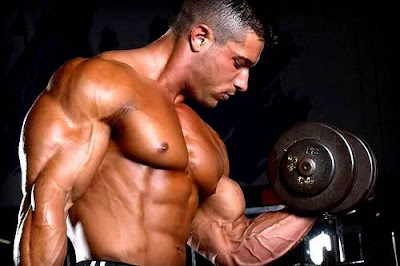
Barbell Rows are hard. Not as hard as Squats or Deadlifts, but certainly harder than the Bench Press. When you get stronger on the Barbell Row, you’ll often see your strength increase on other strength training exercises.
Barbell Rows are the best exercise to train your upper-back. Unfortunately the Barbell Row is often done with incorrect technique. This article will teach you how to perform the Barbell Row with proper technique.
Just like the name sounds, you bend over at the waist and “row” (pull) a barbell to your lower chest/stomach. There are a couple different versions of this exercise, one variation has your hands reversed (palms facing forwards) which work the biceps more… but this article will deal with the “Basic” bent over row as it’s the best for overall back, bicep, and pulling motion development.
Most guys do way too much horizontal pressing (bench press and bench press variations) and way too little of horizontal pulling motions. The bent over row will help you fix that problem. It’s good for:
* Building Back Strength – being able to pull something to your chest is a useful skill, in combat sports you have to do pulling motions like this often…
* Building Back Muscle – most guys look like apes from too much benching and not enough pulling, the bent over row helps correct that, add muscle to your upper back and will actually help your other lifts (plus, a thick upper back looks great and chicks dig it!)

1. Holding a barbell with a pronated grip (palms facing down), bend your knees slightly and bring your torso forward, by bending at the waist, while keeping the back straight until it is almost parallel to the floor. Tip: Make sure that you keep the head up. The barbell should hang directly in front of you as your arms hang perpendicular to the floor and your torso. This is your starting position.
2. Now, while keeping the torso stationary, breathe out and lift the barbell to you. Keep the elbows close to the body and only use the forearms to hold the weight. At the top contracted position, squeeze the back muscles and hold for a brief pause.
3. Then inhale and slowly lower the barbell back to the starting position.
4. Repeat for the recommended amount of repetitions.
Caution: This exercise is not recommended for people with back problems. A Low Pulley Row is a better choice for people with back issues.
Also, just like with the bent knee dead-lift, if you have a healthy back, ensure perfect form and never slouch the back forward as this can cause back injury.
Be cautious as well with the weight used; in case of doubt, use less weight rather than more.
Torso may be keep horizontal for strict execution. Knees are bent in effort to keep low back straight (See Hamstring Inflexibility). If low back becomes rounded due to tight hamstrings, either try bending knees more or don't position torso as low. Either fix may compromise involvement of Latissimus Dorsi since it forces more shoulder transverse extension and less shoulder extension range of motion. If low back is rounded due to poor form, deadlift weight to standing position and lower torso into horizontal position with knees bent and back straight. A shoulder width or underhand grip can increase lat involvement by emphasizing shoulder extension over transverse extension. A wide overhand grip involves overall back musculature while slightly emphasising Rear Delt, Infraspinatus and Teres Minor involvement.


























